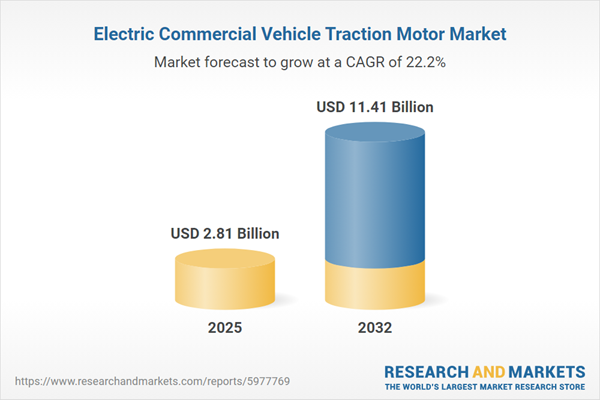Speak directly to the analyst to clarify any post sales queries you may have.
Senior decision-makers engaged in the electric commercial vehicle traction motor market face a landscape shaped by regulatory shifts, swift technological change, and rising sustainability demands. Critical market intelligence is essential to support confident operational strategies in this evolving sector.
Market Snapshot: Electric Commercial Vehicle Traction Motor Market
The electric commercial vehicle traction motor market is currently valued at USD 2.30 billion, with projections signaling expansion to USD 2.81 billion by 2025 and USD 11.41 billion by 2032. This substantial compound annual growth rate reflects intensifying emission reduction mandates, rapid propulsion system innovation, and coordinated OEM-supplier efforts to strengthen reliability while lowering overall fleet emissions. Global climate commitments are accelerating the shift to electric propulsion in commercial trucks, buses, and vans, creating sustained demand for specialized solutions that address rigorous operational requirements unique to fleet environments.
Scope & Segmentation for Senior Executives
This research offers in-depth segmentation to empower procurement, engineering, and operational leaders across regions and fleet profiles:
- Technology Types: Includes induction motors, permanent magnet motors (both ferrite and neodymium), and switched reluctance designs, evaluated for efficiency, straightforward maintenance, and lifecycle durability.
- Applications: Covers commercial trucks, buses, and vans; analysis considers how the right propulsion technologies can optimize fleet duty cycles and varied use cases.
- Output Power Range: Encompasses sub-100 KW, 100–200 KW, and above 200 KW motor segments, supporting alignment with payload capacity, overall energy efficiency, and long-term operational costs.
- Cooling Systems: Compares advantages of air-cooled and liquid-cooled solutions, focusing on performance, prolonged reliability, and effective thermal management during high-utilization cycles.
- Voltage Level: Reviews 400 V and 800 V architectures, providing insight for executives evaluating infrastructure investments and anticipating evolving compatibility standards.
- Motor Speed Options: Details low, medium, and high-speed variants, aiding selection based on specific route demands and operational intensity within the commercial sector.
- Regional Perspectives: Focuses on the Americas, Europe, Middle East, Africa, and Asia-Pacific; considers regulatory backdrops, manufacturing capabilities, and maturity in key opportunity areas such as China, India, and Japan.
- Major Companies: Profiles Nidec Corporation, BorgWarner Inc., Siemens Aktiengesellschaft, ABB Ltd, Robert Bosch GmbH, Dana Incorporated, ZF Friedrichshafen AG, Hitachi Automotive Systems, WEG Equipamentos Elétricos S.A., and Schaeffler AG, highlighting innovation and differentiation in global supply strategies.
Key Takeaways for Informed Decision-Making
- Implementing robust design and engineering standards enhances fleet reliability and optimizes vehicle uptime.
- Strategic sourcing of essential materials—including copper, steel, and advanced magnets—reduces procurement risk and fortifies supply chains.
- Adaptation to dynamic regulations and expanded charging infrastructure requires flexible technology planning and updated procurement cycles among fleet operators.
- Adoption of predictive maintenance tools and advanced diagnostics improves asset management and lowers the incidence of unexpected downtime.
- Leveraging modular propulsion architectures supports compliance agility and timely adaptation to new standards, simplifying the manufacturing process.
Tariff Impact: Navigating Cost and Supply Chain Dynamics
Recent tariff adjustments in the United States have forced stakeholders to reevaluate sourcing and manufacturing strategies in the electric commercial vehicle traction motor space. Fluctuations in material prices, especially for copper and rare-earth magnets, have prompted broader supplier diversification and a move toward near-shoring. Intensified efforts to recycle key materials are enhancing resilience within supply chains, helping organizations withstand volatility associated with shifting international trade conditions and maintain operational stability.
Methodology & Data Sources
This analysis integrates executive interviews, feedback from commercial fleet operators, and technical evaluations of traction motor systems. Findings are validated using relevant regulatory documents and peer-reviewed studies, ensuring senior executives have accurate, actionable insights for their planning processes.
Why This Report Matters for the Electric Commercial Vehicle Traction Motor Market
- Delivers targeted intelligence to B2B stakeholders seeking enhanced strategic positioning and effective entry or expansion in the traction motor sector.
- Equips procurement and engineering teams to strengthen supply chain management and compliance, while reducing exposure to regulatory and operational challenges.
- Provides decision-makers with guidance that considers current supply dynamics, evolving policies, and the latest industry standards relevant to fleet electrification.
Conclusion
Access to comprehensive insights allows senior leaders to design strategies that combine innovation, resilience, and regulatory compliance as they steer their organizations through the electric traction motor market's transformation.
Additional Product Information:
- Purchase of this report includes 1 year online access with quarterly updates.
- This report can be updated on request. Please contact our Customer Experience team using the Ask a Question widget on our website.
Table of Contents
3. Executive Summary
4. Market Overview
7. Cumulative Impact of Artificial Intelligence 2025
Companies Mentioned
The companies profiled in this Electric Commercial Vehicle Traction Motor market report include:- Nidec Corporation
- BorgWarner Inc.
- Siemens Aktiengesellschaft
- ABB Ltd
- Robert Bosch GmbH
- Dana Incorporated
- ZF Friedrichshafen AG
- Hitachi Automotive Systems, Ltd.
- WEG Equipamentos Elétricos S.A.
- Schaeffler AG
Table Information
| Report Attribute | Details |
|---|---|
| No. of Pages | 192 |
| Published | October 2025 |
| Forecast Period | 2025 - 2032 |
| Estimated Market Value ( USD | $ 2.81 Billion |
| Forecasted Market Value ( USD | $ 11.41 Billion |
| Compound Annual Growth Rate | 22.1% |
| Regions Covered | Global |
| No. of Companies Mentioned | 11 |









